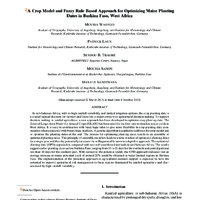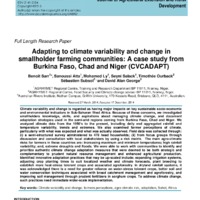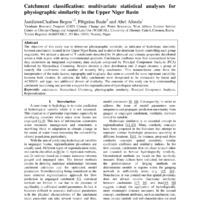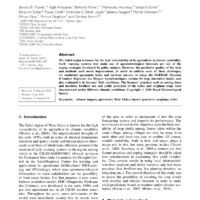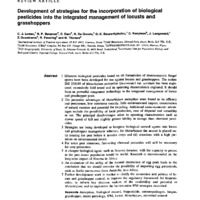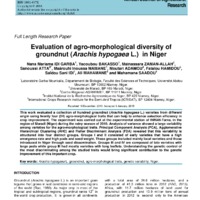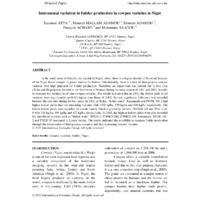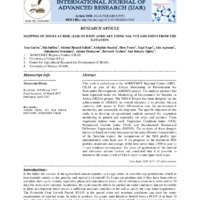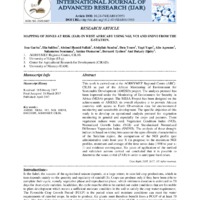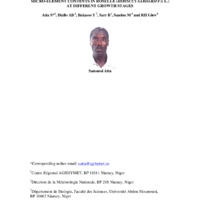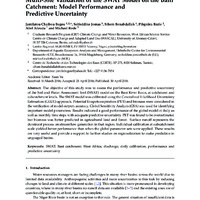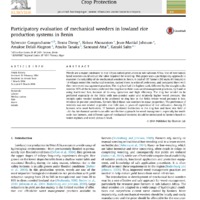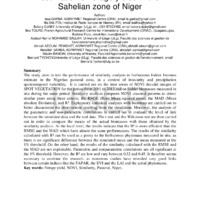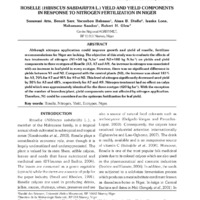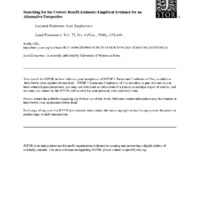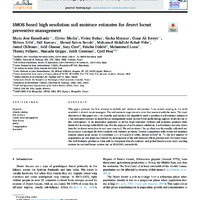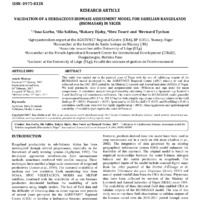Recherche
20 items
A Crop Model and Fuzzy Rule Based Approach for Optimizing Maize Planting Dates in Burkina Faso, West Africa
In sub-Saharan Africa, with its high rainfall variability and limited irrigation options, the crop planting date is a crucial tactical decision for farmers and therefore a major concern in agricultural decision making.
Adapting to climate variability and change in smallholder farming communities: a case study from Burkina faso, Chad and Niger
Climate variability and change is regarded as having major impacts on key sustainable socio-economic and environmental indicators in Sub-Saharan West Africa. Because of these concerns, we investigated smallholders knowledge, skills, and aspirations about managing climate change, and document adaptation strategies used in the semi-arid regions coming from Burkina Faso, Chad and Niger. We analyzed climate data from the 1950’s to the present, including daily and aggregated rainfall and temperature variability, trends and extremes.
Catchment classification: multivariate statistical analyses for physiographic similarity in the upper niger basin
The objective of this study was to determine physiographic similarity, as indicator of hydrologic similarity between catchments located in the Upper Niger Basin, and to derive the dominant factors controlling each group singularity. We utilized a dataset of 9 catchments described by 16 physical and climatic properties distributed across a wide region with strong environmental gradients. Catchments attributes were first standardized before they underwent an integrated exploratory data analysis composed by Principal Component Analysis (PCA) followed by Hierarchical Clustering. Results showed a clear distribution into 2 major clusters: a group of easterly flat catchments and another of westerly hilly catchments. This nomenclature came from the interpretation of the main factors, topography and longitude, that seem to control the most important variability between both clusters. In addition, the hilly catchments were designated to be dominated by forest and ACRISOL soil type, two additional drivers of similarity. The outcome of this study can help understanding catchment functioning and provide a support for regionalization of hydrological information.
Characterizing and modeling the diversity of cropping situations under climatic constraints in west africa
The Sahel region is known for the high vulnerability of its agriculture to climate variability. Early warning systems that make use of agrometerological forecasts are one of the coping strategies developed by policy makers. However, the predictive quality of the tools and methods used needs improvement. In order to address some of these challenges, we conducted agronomic trials and on-farm surveys to adapt the SARRAH (Syst`eme d’Analyse R´egionale des Risques Agroclimatiques, version H) crop simulation model, and also evaluated it in farmers’ field conditions. The farmers’ practices such as sowing dates and densities, fertilizer use and yields potentials of the millet and sorghum crops were characterized under different climatic conditions.
Estimates of Phenotypic and Genotypic Variance and Heritability in Eighty Nine Bambara Groundnut Vigna subterranea (L.) Verdcourt] Accessions Collected from Six Regions of Niger
The bambara groundnut [Vigna subterranea (L.) Verdc. (Fabaceae)] is a legume mainly cultivated by women, for the nutritional quality of these seeds. It is a so-called minor culture and the improvement of the plant and its popularization remains to be promoted. The objective of this present work is to evaluate the genetic variability of bambara groundnut accessions. The experiment was carried out according to a completely randomized block device with four replications. Twenty-two (22) characters including four (4) phenological, four (4) morphological and fourteen (14) related to yield were evaluated for accessions characterization. Descriptive analysis showed significant differences. The coefficients of variation ranged from 3.51% (maturity date) to 38.87% (shell weight). Significantly high values (CV˃20%) for 8 of the metric parameters were observed. Pod weight per plant and seed weight per plant (r=0.943), yield in kg/ha (r=0.943); seed weight per plant and yield in kg/ha (r=0.999) showed the strongest correlations. The phenotypic and genotypic coefficients of variation were high for dry biomass weight (PCV=42.23%; GCV=28.40%), shell weight (PCV=63.46%; GCV=22.46%) and 100-seed weight (PCV=25.57%; GCV=25.25%). Maturity date (95.77%) and 100-seed weight (99.84%) had high heritabilities. Broad-sense heritability and genetic gain are high for 100-seed weight (H2=99.84%; GA=52.58%). The Ascending hierarchical classification produced four groups of which group 4 is the most efficient in yield with short (20.58cm) early accessions (80.32 days). Groups 1 and 2 include, late accessions (~22cm) with respectively maturity dates (DM=85.67 days and DM=86.53 days.
Evaluating Groundwater Storage Change and Recharge Using GRACE Data: A Case Study of Aquifers in Niger, West Africa
Accurately assessing groundwater storage changes in Niger is critical for long-term water
resource management but is difficult due to sparse field data. We present a study of groundwater
storage changes and recharge in Southern Niger, computed using data from NASA Gravity Recovery
and Climate Experiment (GRACE) mission. We compute a groundwater storage anomaly estimate
by subtracting the surface water anomaly provided by the Global Land Data Assimilation System
(GLDAS) model from the GRACE total water storage anomaly. We use a statistical model to fill
gaps in the GRACE data. We analyze the time period from 2002 to 2021, which corresponds to the
life span of the GRACE mission, and show that there is little change in groundwater storage from
2002–2010, but a steep rise in storage from 2010–2021, which can partially be explained by a period
of increased precipitation. We use the Water Table Fluctuation method to estimate recharge rates
over this period and compare these values with previous estimates. We show that for the time range
analyzed, groundwater resources in Niger are not being overutilized and could be further developed
for beneficial use. Our estimated recharge rates compare favorably to previous estimates and provide
managers with the data required to understand how much additional water could be extracted in a
sustainable manner.
Evaluation of agro-morphological diversity of groundnut (Arachis hypogaea L.) in Niger
This work evaluated a collection of hundred groundnut (Arachis hypogaea L.) varieties from different origin using twenty four (24) agro-morphological traits that can help to enhance selection efficiency in crop improvement. The experiment was carried out at the experimental station of INRAN-Tarna, in the region of Maradi (Niger) during the rainy season of 2010. Analysis of variance showed a large variability among varieties for the agro-morphological traits. Principal Component Analysis (PCA), Agglomerative Hierarchical Clustering (AHC) and Fisher Discriminant Analysis (FDA) revealed that this variability is structured into four distinct groups. Groups I and II consisted of early varieties that have a high emergence rate and high pods and seed weight. These groups included mainly local varieties and those introduced in Niger through seed dissemination. Groups III and IV are composed of late varieties with large pods while group III had mostly varieties with long leaflets. Understanding the genetic control of the most discriminating among the studied traits would bring significant contribution to the genetic improvement of this important crop.
Evaluation of the Impact of Seasonal Agroclimatic Information Used for EarlyWarning and Farmer Communities’ Vulnerability Reduction in Southwestern Niger
Abstract: In Niger (a fully Sahelian country), the use of climate information is one of the early warning strategies (EWSs) for reducing socio-economic vulnerabilities in farmer communities. It helps farmers to better anticipate risks and choose timely alternative options that can allow them to generate more profit. This study assesses the impacts of the use of climate information and services that benefit end-users. Individual surveys and focus groups were conducted with a sample of 368 people in eight communes in Southwestern Niger. The survey was conducted within the framework of the
ANADIA project implemented by the National Meteorological Direction (NMD) of Niger. The survey aims to identify different types of climate services received by communities and evaluates the major benefits gained from their use. Mostly, the communities received climate (73.6%) and weather (99%) information on rainfall, temperature, dust, wind, clouds, and air humidity. Few producers in the area (10%) received information on seasonal forecasts of the agrometeorological characteristics of the rainy season. The information is not widely disseminated in the villages during the roving seminars conducted by the NMD. For most people, this information is highly relevant to their needs because of its practical advice for options to be deployed to mitigate disasters for agriculture, livestock, health, water resources, and food security. In those communities, 82% of farmers have (at least once) changed their routine practices as a result of the advice and awareness received according to the climate
information. The information received enables farmers (64.4%) to adjust their investments according to the profile of the upcoming rainfall season. The use of climate information and related advice led to an increase of about 64 bunches (equivalent to 10 bags of 100 kg) in annual millet production, representing an income increase of about 73,000 FCFA from an average farmland of 3 ha per farmer. In addition, the use of climate information helps to reduce the risks of floods and droughts, which often cause massive losses to crop production, animal and human life, infrastructure, materials, and goods. It has also enabled communities to effectively manage seeds and animal foods and to plan
social events, departures and returns to rural exodus. These analyses confirm that the use of climate information serves as an EWS that contributes to increasing the resilience of local populations in the Sahel.
Interannual variation in fodder production in cowpea varieties in Niger
In the south areas of Niamey, the capital of Niger, where there is a higher density of livestock because of the Niger River, cowpea is grown mainly for fodder. Unfortunately, there is a lack of dual-purpose cowpea varieties with high potential for fodder production. Therefore, an experiment was carried out in two sites (Ticko and Bogodjotou) located in the Southwest of Niamey during the rainy season of 2001 and 2002, in order to compare the production of nine cowpea varieties. The results indicated that in 2001, the fodder yield of all varieties were significantly (p<0.01) higher than those of 2002. But not significant difference was recorded between the two sites during the two years. In 2001, at Ticko, “Baban waké", Kanannado and IT93K-398-2 had higher fodder yields than the remaining varieties with 1032 kg/ha, 879 kg/ha and 866 kg/ha respectively. The lowest fodder yields were recorded for Locale variety which is grown by farmers, IT89KD-349 and TVu 1234- 9 with 715 kg/ha, 499 kg/ha and 677 kg/ha, respectively. In 2002, the highest fodder yields were also recorded for introduced varieties such as “Baban waké", IN92E-3, IT89KD-288, IT89KD-349, Kanannado, IT93K-398- 2 and TN256-87 compared to Locale variety. The results indicated the possibility to increase fodder production through the introduction of dual-purpose cowpeas and thus increasing farmers’ income. © 2011 International Formulae Group. All rights reserved.
Mapping of Zones At Risk (ZAR) in west Africa by using NGI, VCI and SNDVI from the E-statuib
This work is carried out at the AGRHYMET Regional Centre (ARC)-CILSS as part of the African Monitoring of Environment for Sustainable Development (AMESD) project. The analysis protocol has been improved under the Monitoring of Environment for Security in Africa (MESA) project. The MESA Project has been designed on the achievements of AMESD; its overall objective is to provide African countries with access to Earth Observation data for environmental monitoring and sustainable development. The specific objective of this study is to develop an operational analysis protocol for vegetation monitoring in general and especially for crops and pastures. Three vegetation indices were used: Vegetation Condition Index (VCI), Normalized Growth Index (NGI) and Standardized Normalized Difference Vegetation Index (SNDVI). The analysis of these drought indices is based on taking into account the agro-climatic characteristics of the Sahelian region, the comparison of the NGI profile (per administrative unit) from year X (in progress) to the maximum NGI profiles, minimum and average of the time series data (1998 to year x-1) and evidence convergence. Six years of application of the method and validation actions carried out concluded that it is possible to determine the zones at risk (ZAR) in order to anticipate food crises.
Mapping of zones at risk in west Africa by using NGI, VCI and SNDVI from the E-Station.
This work is carried out at the AGRHYMET Regional Centre (ARC)-CILSS as part of the African Monitoring of Environment for Sustainable Development (AMESD) project. The analysis protocol has been improved under the Monitoring of Environment for Security in Africa (MESA) project. The MESA Project has been designed on the achievements of AMESD; its overall objective is to provide African countries with access to Earth Observation data for environmental monitoring and sustainable development. The specific objective of this study is to develop an operational analysis protocol for vegetation monitoring in general and especially for crops and pastures. Three vegetation indices were used: Vegetation Condition Index (VCI), Normalized Growth Index (NGI) and Standardized Normalized Difference Vegetation Index (SNDVI). The analysis of these drought indices is based on taking into account the agro-climatic characteristics of the Sahelian region, the comparison of the NGI profile (per administrative unit) from year X (in progress) to the maximum NGI profiles, minimum and average of the time series data (1998 to year x-1) and evidence convergence. Six years of application of the method and validation actions carried out concluded that it is possible to determine the zones at risk (ZAR) in order to anticipate food crises.
MICRO-ELEMENT CONTENTS IN ROSELLE (HIBISCUS SABDARIFFA L.) AT DIFFERENT GROWTH STAGES
In the western Sahel, leaves of Roselle (Hibiscus sabdariffa) have considerable economic importance because of their nutritional and medical uses. These plant organs are used to supplement nutrients provided by cereals such as millet and sorghum. However, there is a lack of information on the nutrient composition of these plant organs of Roselle at different growth stages. Therefore, the experiment was carried out under rainfall conditions during the 2006 rainy season (from July to September) at the experimental station of the Agrhymet Regional Centre in Niamey (Niger). The content of the micronutrients Fe, Mn, Cu and Zn in leaves of three ecotypes of Roselle (A3, A7 and A9) at three growth stages, vegetative (stage I), flowering (stage II), and mature (stage III) was determined. The experimental design was a randomized complete block with four replicates and one variable (ecotype). Results indicated that at stage I, ecotype A3 had higher Fe content in leaves. In addition, A3 had also the highest Zn content in leaves at stage I. For all three ecotypes, Fe and Zn content in the leaves decreased significantly (p<0.05) from stage I to stage II, then remained constant until stage III. For Fe, the decrease between stage I and II was 37& for A3 and 50&, respectively for A7 and A9. The corresponding decrease of Zn content was 30& for A7 and 50&, respectively, for A3 and A9. The Mn content in the leaves of Roselle was similar for the three ecotypes at stage I, thereafter increased continuously during plant growth. From stage I to II, the increase was about 90&, 70& and 50&, respectively for A9, A7 and A3. From stage II to III, the increase in Mn content in the leaves was significantly (p<0.05) higher for A3 and A7, respectively 180& and 80&. At stages I and II, the highest Cu content was recorded for A3 and the lowest one for A7. During the whole cycle of plant growth, the Cu content in the leaves was relatively constant for A9. In contrast, Cu content in the leaves decreased for the remaining ecotypes. Therefore the vegetative stage corresponding to 25 days after sowing is the recommended optimal harvest time of Roselle to maximise on the nutrients.
Multi-site validation of the swat model on the bani catchment: model performance and predictive uncertainty
The objective of this study was to assess the performance and predictive uncertainty of the Soil and Water Assessment Tool (SWAT) model on the Bani River Basin, at catchment and subcatchment levels. The SWAT model was calibrated using the Generalized Likelihood Uncertainty Estimation (GLUE) approach. Potential Evapotranspiration (PET) and biomass were considered in theverificationofmodeloutputsaccuracy. GlobalSensitivityAnalysis(GSA)wasusedforidentifying important model parameters. Results indicated a good performance of the global model at daily as well as monthly time steps with adequate predictive uncertainty. PET was found to be overestimated but biomass was better predicted in agricultural land and forest. Surface runoff represents the dominant process on streamflow generation in that region. Individual calibration at subcatchment scale yielded better performance than when the global parameter sets were applied. These results are very useful and provide a support to further studies on regionalization to make prediction in ungauged basins.
Participatory evaluation of mechanical weeders in lowland rice production systems in Benin
Weeds are a major constraint to rice (Oryza sativa) production in sub-Saharan Africa. Use of mechanical hand weeders could reduce the labor required for weeding. This paper uses a participatory approach to examine the suitability of six mechanical weeders in Benin. A total of 157 farmers (93 male, 64 female) in 14 villages tested the mechanical weeders, ranked them in order of preference, and compared them with their own weed management practices. The ring hoe had the highest rank, followed by the straight-spike weeder; 97& of the farmers preferred the ring hoe to their own weed management practices, by hand or using traditional hoe, because of its easy operation and high efficiency. The ring hoe tended to be preferred especially in the fields with non-ponded water and relatively higher weed pressure. The straight-spike weeder tended to be preferred to ring hoe in the fields where weed pressure is less, whereas in ponded conditions, farmers liked these two weeders in equal proportion. The preference of weeders was not related to gender, rice field size, or years of experience of rice cultivation. Among 23 farmers who used herbicides, 17 farmers preferred herbicides to the ring hoe and have rice field of >0.5 ha. Mechanical weeders can offer an effective approach for weed management, especially for smallscale rice farmers, and different types of mechanical weeders should be introduced to farmers based on water regimes and weed pressure level.
Performance of similarity analysis in the estimation of forage yields in the Sahelian zone of Niger
The study aims to test the performance of similarity analysis in herbaceous fodder biomass estimate in the Nigerian pastoral zone, in a context of insecurity and precipitation spatiotemporal variability.
ROSELLE (HIBISCUS SABDARIFFA L.) YIELD AND YIELD COMPONENTS IN RESPONSE TO NITROGEN FERTILIZATION IN NIGER
Although nitrogen application could improve growth and yield of roselle, fertilizer recommendations for Niger are lacking. The objective of this study was to evaluate the effects of two treatments of nitrogen (N1=50 kg N,ha-1 and N2=100 kg N.ha-1) on yields and yield components in three ecotypes of Roselle (A3, A7 and A9). An increase in nitrogen was associated with an increase in leaf yield in every ecotype. However, there was no significant difference in yields between N1 and N2. Compared with the control plants (N0), the increase was about 181& for A3, 70& for A7 and 95& for A9 at N2. This level of nitrogen significantly decreased seed yield by 30& for A3 and 48&, respectively for A7 and A9. Nitrogen treatment had no effect on calyx yield which was approximately identical for the three ecotype (420 kg ha-1). With the exception of the number of branches/plant, yield components were not affected by nitrogen application. Therefore, N1 could be considered as the optimum fertilization for leaf yield.
Searching for the correct benefic stimate : empirical evidence for an alternative perspective
Estimate the value of flood risk reduction
SMOS based high resolution soil moisture estimates for desert locust preventive management
This paper presents the first attempt to include soil moisture information from remote sensing in the tools available to desert locust managers. The soil moisture requirements were first assessed with the users. The main objectives of this paper are: i) to describe and validate the algorithms used to produce a soil moisture dataset at 1 km resolution relevant to desert locust management based on DisPATCh methodology applied to SMOS and ii) the development of an innovative approach to derive high-resolution (100 m) soil moisture products from Sentinel-1 in synergy with SMOS data. For the purpose of soil moisture validation, 4 soil moisture stations where installed in desert areas (one in each user country). The soil moisture 1 km product was thoroughly validated and its accuracy is amongst the best available soil moisture products. Current comparison with in-situ soil moisture stations shows good values of correlation (R > 0.7) and low RMSE (below 0.04m3 m−3). The low number of acquisitions on wet dates has limited the development of the soil moisture 100m product over the Users Areas. The Soil Moisture product at 1 km will be integrated into the national and global Desert Locust early warning systems in national locust centres and at DLIS-FAO, respectively.
Validation of a herbaceous biomass assessment model for selected rangelands
This study was carried out in the pastoral zone of Niger with the aim to validating outputs of the BIOMASAH model developed by the AGRHYMET Regional Centre (ARC) relative to real data collected over the 2001 2011 period by the Ministry of Livestock and Animal Industries of Niger
